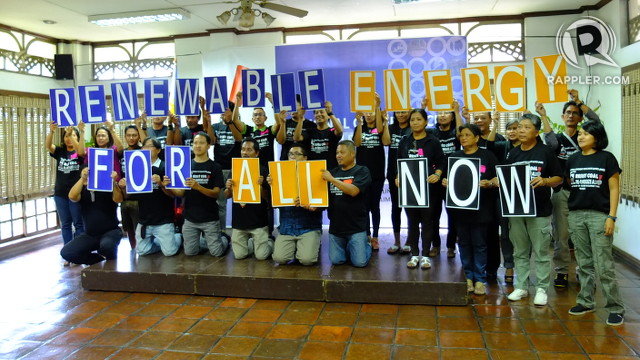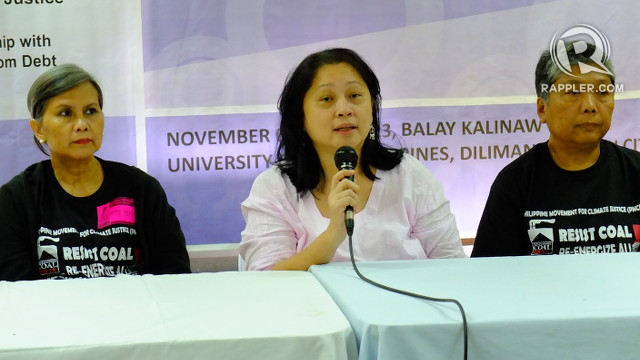SUMMARY
This is AI generated summarization, which may have errors. For context, always refer to the full article.
MANILA, Philippines – Despite the government’s Renewable Energy Plan, the country’s energy outlook remains very much coal-oriented.
This was the major grievance expressed by environmentalists during the National Conference on People’s Energy held from November 4 to 6 in Quezon City.
“In spite of the stated goal of increasing renewable energy in the Philippines, in its actual content, it’s still very focused on scaling up fossil fuel energy, in particular coal,” Philippine Movement for Climate Justice (PMCJ) Convenor Lidy Nacpil told Rappler.
As of August, there were 31 coal operating contracts at the development and production stage, she said. An additional 17 coal plant projects using a total of 26 boiler facilities are in the pipeline.
But even without these coal plants being built, 84% of Philippine energy is already derived from fossil fuels, a non-renewable source of energy responsible for 35% of global greenhouse gas emissions. (READ: Palawan may lose UNESCO citation over planned coal plant)
This despite the Renewable Energy Act of 2008 which states that the government must “accelerate the exploration and development of renewable energy resources such as biomass, solar, wind, hydro, geothermal and ocean energy sources…to reduce the country’s dependence on fossil fuels.”
While Nacpil said the DOE is “laudable” for their concern in ensuring enough energy supply for Filipinos, the increase in coal plant projects has not done much for poor communities in the country.
“In our experience, when there is an expansion of energy generation, there has not been any corresponding increase in energy access for marginalized sectors and communities,” she said.
In Mindanao, for example, the government approved 4 coal plants to be built in Sarangani and General Santos ostensibly to address the frequent power outages experienced by the 600 barangays in Mindanao. But locals soon found out that two of the coal plants are intended to supply the power needs of the Tampakan Mining Project.
There are 2.5 million Filipino households who still do not have access to electricity, according to studies done by PMCJ, a coalition of 103 national and local organizations fighting fossil fuel projects.
Coal’s hidden costs
Coal as a source of energy has been fiercely opposed by various sectors for its negative impacts on human health and the environment.
The entire process of mining, extracting and combusting coal causes extreme pollution with different toxic chemicals like nitrous oxide, carbon dioxide and sulfur oxide released into the atmosphere.
These hazardous substances have been found to cause lung problems and other diseases, pollute water systems and kill animals and plants in nearby ecosystems. Open-pit mining of coal leads to landslides and endangers the lives of pit workers and communities.
But Nacpil admitted that getting rid of coal-derived energy in the Philippines can’t be done overnight. Existing coal plants that feed into the National Grid cannot be dismantled until a substitute source of energy is provided.
But the least the government can do is to stop building new coal plants. “We should phase out the existing coal plants as fast as we can when we have replacements. In the meantime, let’s stop building new ones,” she urged.
The most obvious reason for the aggressive increase in coal plants is that the technology is way cheaper than renewable energy. More capital is needed for renewable energy which requires more advanced technology. (READ: Palawan DMCI coal plant to convert to natural gas?)
But there are hidden costs to coal.
“It may be financially cheap but it costs much more in terms of people and the environment. They aren’t considering the financial cost of deteriorating health in communities or deteriorating ecosystems,” said Nacpil.

Locked into coal
At the same time, the cost of renewable energy is declining. In a few years time, the price will match that of fossil fuel technology. Renewable energy currently accounts for only 13% of total power supply in the country.
The problem with the government pursuing coal alongside their Renewable Energy Plan is that one comes at the expense of the other.
“You don’t set up (a coal plant) and say we’ll only use it only for the next 3 years. It locks us in in the use of these projects for the next 20 years.
“It’s like saying we are committed to build houses near the beach. In the meantime, we’ll build this other house. When that house is put up, it’s now your disincentive to build a new house in the beach because you already have the first house,” explained Nacpil.
If the advocates at the conference would have their way, the national budget should prepare to invest in renewable energy.
“President Aquno should make sure this happen by mobilizing his Department of Finance to look for the funds,” Nacpil insisted. “Why are we not using the Malamapaya which is under the President’s discretion to fund renewable energy? He cannot make us believe that there is no money. It’s not acceptable.” – Rappler.com
Add a comment
How does this make you feel?







There are no comments yet. Add your comment to start the conversation.